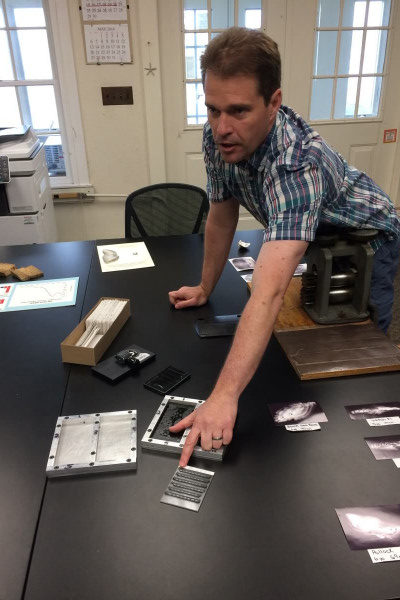
Eric Robillard, fisheries biologist with the Northeast Fisheries Science Center, shares his knowledge with visitors. Staff photo by Doreen Leggett
By Doreen Leggett
Located in Pocasset, a few miles away from the heart of the research mecca that is Woods Hole, sits a boxy, industrial building with old “rockhopper” fishing gear – nets built to drag the bottom with big tires bouncing over rocks – piled outside and a cavernous space inside where fishing nets are fixed and prepped to be used in scientific studies.
To the side of the twine- and tool-filled room run by NOAA, the National Oceanic and Atmospheric Administration, is a spot reminiscent of the last scene of “Raiders of the Lost Ark.” Row upon row upon row of tall metal shelves line either side, all filled with cardboard boxes, names and dates inscribed, looking like sentries marching into dimly-lit space.
Yellowtail 1955, 1956
Redfish 1950
Haddock 1965
Cod – Altantic, ’72
“I think we have more than 2 million samples,” said Eric Robillard, who heads the Fishery Biology Program. “We have samples from 1937 … Oh, and cod, pollock and haddock from 1920. We actually have the captain’s logbook.
“We are one of only two places in the world that has samples that far back.”
The fish scales and other samples stored there provide clues to the health and make-up of the ocean for close to 100 years.
Climate change impacts? Environmental variability? How various species relate to one another to help further the science of ecosystem-based management?
Answers to these key questions need a baseline, a way to compare now with the past. That information lurks within these cardboard boxes, nearly 2000 of them and growing.
“We process 50,000 or 75,000 samples a year,” said Robillard. “The clearer the picture, the less uncertainty, and the more precise we are the more we can let (fishermen) fish.”
Robillard, an energetic man in his 40s, was standing a few miles away in what is called “the cottage,” the age and growth lab of the Northeast Fisheries Science Center. The center has been around since 1871.
Robillard and his team of 10 keep track of 22 species and feed federal regulators information. Some of it is bleak; from the 1960s to the 1980s most of the older silver hake began to disappear. But some is hopeful; haddock had a banner year in 2003 that even today allows fishermen to catch more of the flaky white fish.
Back then researchers from the science center met with about 40 fishermen in the former office of the Fishermen’s Alliance in North Chatham to spread the news.
“We were told to start preparing ourselves to target haddock,” the Fishermen’s Alliance’s CEO John Pappalardo remembers.
So the fleet did, and some fishermen launched a study that used different bait to see if longlines could target haddock and avoid more heavily-regulated cod. It was a success.
“It just gave us an opportunity to switch our fishing plans for the next three or four years,” Pappalardo said. “We were landing several million pounds of haddock overnight as a community. It was an important economic driver in those years.”
Robillard said his office has continued to track those fish, which were followed by even larger year classes. Their information convinced regulators to decrease the size limit on haddock, which were not growing as fast – likely because of the sheer numbers of them – so fishermen could still benefit. Some agreed with that decision, some did not, but for Robillard the hope is the better his science, the better the policy becomes.
Processing samples from so many fish over the years has given scientists a lot of insight and they are moving away from some older methods of aging.
The lab is transitioning from fish scales to working with otoliths, a bone in the inner ear that helps with balance and movement.
Although the otoliths look non-descript, they provide an abundance of information. Robillard takes out a sample and points to dark narrow bands; think of tree rings.
“That’s the winter,” he says. “They are just trying to survive.”
Robillard said that some fish get banged up a fair amount, making them look older than they actually are. But otolith rings don’t lie.
Some of the fish with larger ones, such as cod and haddock, are cut with a saw. For flat fish which have smaller otoliths (because they don’t spend as much time moving vertically in the water column), the technicians use a jeweler’s saw made to cut diamonds, but in this case cutting bone. Samples are held in place by candle wax.
Some species like monkfish simply can’t be aged through that ear bone. Researchers have tried to age the enormous-jawed fish through a lantern-ish appendage that springs out of its head, but, as of yet, it’s unclear if that will be effective.
Robillard appreciates a good mystery. And he finds working with fishermen rewarding.
One of his earliest successes was working on red snapper in the Gulf of Mexico. The big question was whether there was a healthy population in Georgia. He worked with fishermen and some came in with 20-year-old fish.
“They used that as a building block,” Robillard said. “It was really cool to have the fishermen involved to help me out.”
He also got help on a burning question from his thesis; he believed bluefish spawn 30 or 40 miles offshore. But people were challenging him on his premise.
So a fisherman described some unusual behavior far offshore and invited him along.
“That sounds crazy, but let’s go,” Robillard remembers saying.
Turns out that Robillard was right, contrary to popular belief bluefish were spawning offshore.
Robillard still enjoys challenges; he recently aged a 232-year old quahog for a fisherman. And he still grapples with questions: Where do bluefish go in the winter? Why did a monkfish 2000 feet underwater have a bird in its stomach?
“I love the water, the mystery of it,” he says.
